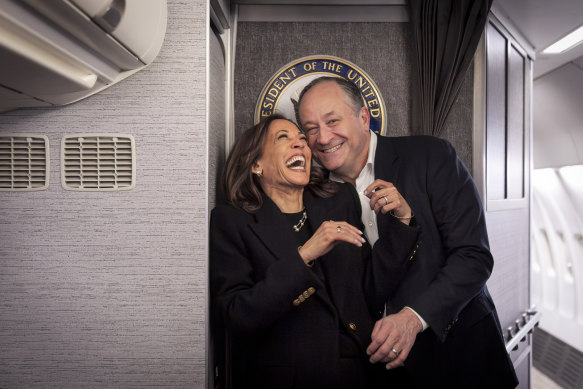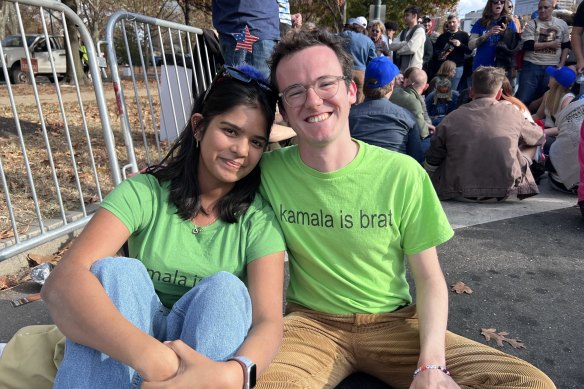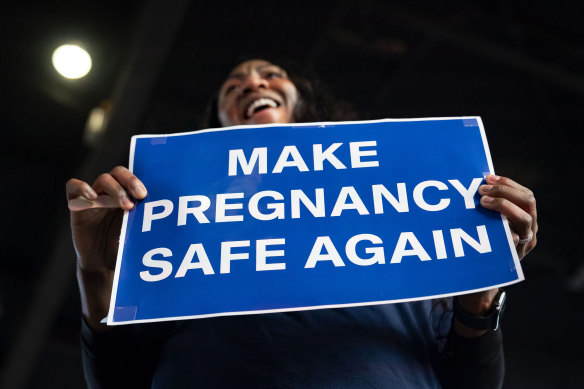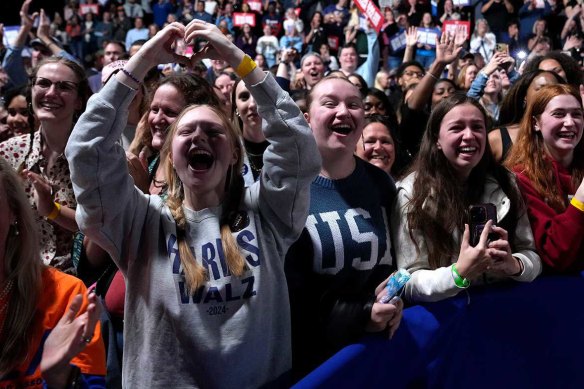This was published 7 months ago
In this election cliffhanger, it might all come down to boys versus girls
Below is an excerpt from the latest Harris v Trump edition of our What in the World newsletter. Sign up to get the whole newsletter delivered to your inbox.
Greetings from Pennsylvania on the eve of the most extraordinary election I’ve covered.
I’m writing from Philadelphia, where crowds have been gathering for hours to attend Kamala Harris’ final pitch to voters before America decides who will become its 47th president.

Vice President Kamala Harris and husband Doug Emhoff aboard Air Force Two, just before taking off from Pittsburgh on Monday.Credit: AP
There’s a nervous excitement in the air – the kind you get when you know you’re on the cusp of a history-defining moment, whatever the outcome may be.
Lengthy queues stretch all the way down the Benjamin Franklin Parkway, the leafy boulevard that extends from Logan Circle to the Philadelphia Museum of Art, where the vice president’s star-studded rally will soon take place featuring Lady Gaga, Ricky Martin and Oprah Winfrey.
As helicopters fly overhead, a white ute with a giant billboard with Harris’ face laps around the venue, which is adorned with familiar slogans: “Freedom”, “For The People”, “Country Over Party”.
“I’m kind of nervous about how close the polls are, especially in the swing states,” says 26-year-old Sumali Jayakody, who is here from New York with friend Leon Ebel. Both wear lime green “Kamala is Brat” T-shirts.
“I just hope everything works out. She’s speaking for women and women’s rights, and she’s a person of colour. I hope she gets to be the first female president because she’d be really amazing.”
There’s a reason both Harris and Donald Trump have descended on Pennsylvania for the final hours of their campaigns in a last-minute sprint for votes.
As I wrote last month, what makes this battleground so important is that it has 19 Electoral College votes up for grabs, which is the biggest haul of all the swing states in play this year. (Candidates have to get 270 Electoral College votes to become president.)

Kamala Harris supporters Sumali Jayakody (left) and Leon Ebel are nervous about the election result.Credit: Farrah Tomazin
Pennsylvania has selected the eventual president eight times in the past 10 elections: including Trump in 2016 and Joe Biden in 2020.
This time, it was Biden’s decision to withdraw from the race that upended the political landscape completely.
Suddenly, Trump was the oldest candidate running for office. Suddenly, there was a genuine contest. And suddenly, women and young people were out in force: the two voting blocs that I’ve long believed could end up determining who wins the White House.
“For a lot of people, it looked like this year was going to be a repeat of 2020, and people weren’t too excited for either candidate,” says Nathaniel Bowman, a 22-year-old student from Washington, DC, who secured pole position at the front of the line to enter the rally after arriving at 12.15am.

A Harris supporter in North Carolina. Harris has put reproductive rights front and centre of her campaign.Credit: AP
“I think Kamala Harris entering this race has really excited and energised a lot of people who really weren’t feeling that energised for this election. And now it’s kind of flipped on its head. You can feel the difference.”
The difference was evident even at Harris’ first rally in Philadelphia in August, when she announced her vice presidential running mate, Tim Walz.
I’d been to countless rallies before that, but never had I seen so many women – and in particular young women – and they’ve been filling halls and stadiums across America at Harris rallies since.
Pollster John Zogby, of John Zogby Strategies, says polls have been closely examining the gender gap since 1988. That gap – the difference between male and female voting support – has generally been a difference of about 15 per cent.

Young women are especially keen to vote for Kamala Harris, polling indicates.Credit: AP
This year, he notes, the gap has been as high as 30 to 35 per cent, with Trump leading among men and Harris leading among women. But when you look at men and women aged 18 to 34, the gap has been as high as 60 points.
“This is astounding,” Zogby says. “Forgive the bluntness here, but this election all comes down to the boys versus the girls.”
“So let’s look at Kamala Harris,” he adds. “She is the first woman of colour running for president. She has not emphasised that fact, but it’s there, and it’s certainly recognised by women – and by young women.
“But of greater significance is the fact that, beyond the economy – which is baked in as the top issue of the campaign – what is very important to young women is, in this order: No.1, reproductive rights; No.2, climate change; and No.3, Gaza. And you find her emphasising two out of those three, and trying to finesse the Gaza war but really not parting much in any way with President Biden.”
Whether this has been a winning strategy will be known soon enough.
But at Harris’ election eve rally in Philadelphia, there’s no shortage of supporters feeling hopeful that maybe – just maybe – change is coming.
Until next time.
Farrah.
Sign up for our What in the world newsletter to get a note from our foreign correspondents around the globe delivered to your inbox each Thursday.